|

Kolyma Highway, Oimyakon, Russia.
Hitchhiking to Oimyakon and beyond
|
The small Yakut village of Oymyakon is known as the World's
coldest permanently inhabited place. The surrounding area is also the one with
the most continental climate: temperatures reach 42C (108F) in summer, but drop
to -70C (-94F) in winter. This part of Northeastern Siberia is one of the less-known
and less-visited places in Asia. Its unique beauty attracts less than ten tourists
a year, almost all of them Russians.
The main access route is the so-called Kolymsky Trakt (Kolyma Highway) - a dirt
road from Magadan city on the Sea of Okhotsk to the infamous gold mines in Kolyma
River valley and surrounding mountains. You can hitchhike along this road, as
heavy trucks make this journey and come back with gold and uranium ore. It usually
takes one-three weeks one way.
|
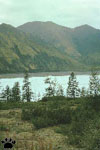
Dancing Graylings Lake,
Kolyma Valley, Russia. |
After you cross Kolyma, villages and mines become scarce. Soon,
you reach the Jack London Lake junction. This lake is said to be the best fishing
place in Siberia, but there is almost no chance of hitchhiking to it. In summer,
you can make this side trip (32 km/20 miles one way) on foot, if you have good
insect repellent. This part of Siberia has almost no native population, and there
is almost no reindeer grazing. As a result, it is the last place to see "yagel
forests" - tundra-like layer of lichens up to 30 cm (1') tall. Try walking
barefoot on it - great massage! |
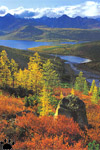
Jack London Lake,
Kolyma Valley, Russia. |
 |
 |
 |
| Brown bear
(Ursus arctos ognevi), Ust-Nera junction, Russia. |
| Just before the town of Ust-Nera, there is another major
junction. From here, the longest, wildest, and most difficult part of the road
begins in summer (in winter you have to go via Ust-Nera - the road changes slightly,
as it goes on surface of frozen rivers). Be ready to wait for the next truck for
a few hours or days - there is very little traffic beyond this point! Once, while
waiting here, I was visited by a bear and had to give it my last couple of crackers
to avoid aggression. If you don't want to take this risk and go beyond Ust-Nera,
you can try to arrange a helicopter trip to Indigirka River Gorge instead. |
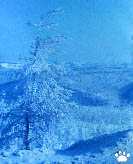
Ice crystals on a larch (Larix
gmelini), Oimyakon, Russia. |

Campfire of Evenk nomads,
Labynkyr Lake, Yakutia, Russia. |
Soon, the road enters Yakutia and passes within 65
km (40 miles) of Labynkyr Lake in a large impact crater. This deep lake is believed
to shelter a lake monster like Nessie, but smaller and more crocodile-like. Surrounding
mountains are populated by Even and Evenk tribes - probably the most ancient peoples
in Asia. These nomadic hunters once traveled with small herds of domestic reindeer
between the Pacific Coast and the Urals. There are a few toponyms of Evenk origin
as far west as the Moscow area. |
| Oimyakon Basin itself looks a bit dull in summer - tiny larch
trees, dry grass, low hills around. On south-facing slopes, you can see the last
remains of the so-called tundrosteppes - the type of grasslands that used
to cover most of Siberia and Alacka about 10000 years ago, before the climatic
change caused the replacement of tundrosteppes by taiga forests. These grasslands,
once home to mammoths, bison and rhinos, still have some relict species of plants.
Tundrosteppes can also be seen in a few places in Northern Mongolia and on Vrangel
Island off Chukchi Peninsula. |
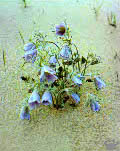
Pulsatilla sibirica, Nalannay
sand dunes, Yakutia. |
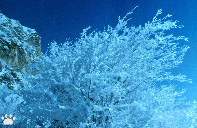
Ice crystals on a blueberry bush,
Oimyakon Basin, Yakutia. |
In winter, these basins become a natural trap for cold air. Siberian
Anticyclone creates sunny weather through most of winter, and ice crystals grow
to the length of 10 cm (4") on grass, bushes, trees, and houses. They also
grow in the air itself: if you look towards the sun, you can see plenty of tiny
"sparkles" flying around. But there is very little snow in these frozen
valleys. |
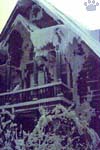
Local hotel,
Oimyakon, Yakutia. |
Ice also grows inside houses, especially around windows, doors
or microscopic pores in the wooden walls. But don't be scared: it can be frosty
in one corner of a room and warm or even hot in the other one, close to an oven.
Local hotels, by the way, are usually comfortable - the only problem is that they
are sometimes a few hundred miles apart. |
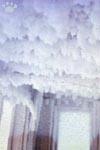
Hotel lobby,
Oimyakon, Yakutia. |
| Wild animals come down to the foothills from surrounding mountains
to feed on grass, as it is not snow-covered here. Surprisingly, many species can
tolerate Antarctic-like frost: Siberian bighorns, wolves, reindeer, wolverines,
foxes, Arctic hares, lynxes, many small mammals
and birds. |

Siberian bighorn (Ovis nivicola),
Tarynnah Canyon, Yakutia, Russia. |
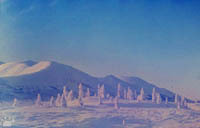
Ice-covered larch trees,
North from Oymyakon, Yakutia. |
People living in these basins have to fight frost for up to seven
months a year. Starting an engine requires such an effort, that most truck drivers
keep them running all night while they take a nap in roadside inns. Trucks usually
survive for only 2-3 years under such conditions. Fortunately, frost is almost
never combined with wind, and the air is usually very dry. |
| In early March of 1992, a friendly helicopter pilot dropped me
off in a remote basin north from Oymyakon - an excellent place to observe wildlife.
What we did not know was that the only wooden cabin in the area had been destroyed
by October storm. I had to hike more than 60 km (40 miles) to reach the Highway.
If the air was more wet, I would be dead in 4-5 hours, but I managed to walk all
the way at -60C (-76F), and only got my cheeks and tops of lungs slightly frostbitten.
The snow was only two inches thick, so hiking was easy. |
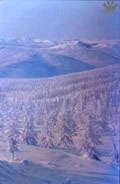
Winter landscape,
Oymyakon Basin, Yakutia. |

Fox den in an old road,
Balygychan uranium
mines, Russia. |
Some of the mines in this area have been used as labor camps
during Stalin's time, but most of them are long abandoned. Following old roads,
you sometimes get to dilapidated remains of wooden barracks and barbed wire fences,
now used by foxes and shrikes. Skulls from mass graves are sometimes offered to
foreigners as souvenirs. |
| Late August is a very beautiful time here. Normally the snow
cover forms in September, but it can also be August or October. In some years,
weasels, hares and ptarmigans turn white too early, and they are killed by predators
in great numbers. In the following years, lynxes and gyrfalcons are in decline,
as lynxes feed mostly on hares, and gyrfalcons on ptarmigans. |

Least weasel
(Mustela nivalis),
Alder Valley, Yakutia |
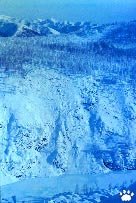
Naled, Corpse Canyon, Yakutia |
Soon after Oimyakon, the road enters the deep gorges of Suntar-Hayata
(Misty Mountains). Driving on frozen rivers is dangerous here: they often freeze
all the way to the bottom, and then break through ice barriers, instantly flooding
canyons downstream. Numerous floods create bright-blue glacier-like ice shields
called naled in Russian or taryn in Yakut. Some of them are more
than a hundred miles long and melt completely only once every few years. Traveling
in the canyons in winter, you must be very careful - although the air seems warm
compared to Oimyakon, it is also less dry, so it takes just a few minutes to get
your lungs and face frostbitten, and less than half an hour to freeze to death
if you are not equipped properly. |
| Narrow canyons of Suntar-Hayata enjoy relatively mild climate,
with a few feet of snow and temperatures above -50C (-58F) in winter. If you enter
this world of dark-blue shadows, green rivers and black rocky slopes from the
barren plains of Oimyakon, you feel like driving through tropical jungle. In some
places the microclimate even allows spruce trees (Picea obovata) to grow,
which is very unusual for larch-dominated Eastern Siberia. During short summer,
plenty of flowers can be seen on riverside meadows and mountain tundras. |
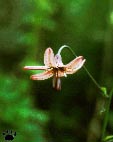
Edible lily (Lilium
pennsilvanicum),
Moose Crack, Yakutia |
 |
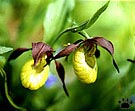 |
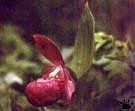 |
Lady's slipper orchids (Cypripedium) are very rare even in
the most remote canyons of Yakutia, but more common in Southern Siberia. |
| Lady's slipper orchids
(Cypripedium maculatum, C. calceolatum, C. macranthon), Warm Spring, Yakutia |
| Some rare and beautiful flowers, normally found only in Southern
and Western Siberia, can be seen around hot springs in the uninhabited area between
Suntar-Hayata and Verhoyansky Range. In this mountain chain, 3 times as long as
Sierra Nevada, there are only two small villages and three mines. Hot springs
do not freeze in winter, and I discovered a wintering population of brown dippers
(Cinclus pallasi), diving in the water despite the frost. Marmots (Marmota
camchatica), bighorns and other species inhabit this range all the way north,
to the Arctic Circle and beyond. Bighorns, reindeer, moose can be seen anywhere
except the 50-km vicinity of roads and settlements. But don't expect them to be
as easy to approach as in Canadian parks! They can only
be seen with good binoculars. Members of geological expeditions, local tribesmen
and helicopter pilots are all armed with rifles, and all are used to poaching.
Foreighn trophy hunters sometimes order expensive helicopter tours to shoot a
helpless bighorn. Bighorns, bears, marmots and musk deer are already extinct in
more accessible parts of Yakutia. |
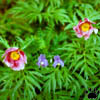
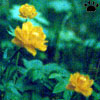
Siberian flowers:
Paeonia tenuifolia,
Trollius asiaticus,
Aktash, Altai |
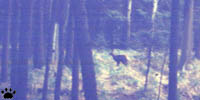
Musk deer (Moschus mosciferus),
Ayan, Okhotsk Sea coast. |
Marmots and bears are hunted for their fat and bale,
believed to have medicinal value, while musk deer are hunted for males' musk glands.
These small, shy creatures inhabit the darkest forests with lots of windfallen
trees, where they create networks of trails to move quickly and quietly through
their territory. They feed almost entirely on Usnea and other tree lichens. |
| In early spring, capercallies and ptarmigans start lekking in
hillside bushes. Capercallies mostly feed on larch buds during the winter. To
make this food source more accessible, they trim trees, so that a heavy bird can
reach buds on small twigs from its perch near the trunk. As a result, capercallies
create the so-called "gardens" - small areas of trimmed trees. They
are difficult to find, as black capercallie populations are small, rare and far
between. Gallinaceous birds, especially hazel grouse, are a rare sight in winter,
as they spend most of time in dens under snow surface. Other large birds wintering
in the area are owls, white goshawks (Acipenser gentilis albidus), ravens
and (the most common) Siberian jays (Perisoreus infaustus). |

Lekking Black
capercallie (Tetrao
urogalloides),
Snowstorm Valley,
Yakutia. |
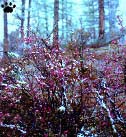
Siberian bagulnik, or kashkara
(Rhododendron dauricus),
Handyga, Yakutia. |
By June, the winter is normally over, but snowfalls can
occur until early July. For 50-70 days a year, it is warm along Kolyma Highway,
especially along its last, westernmost part between Handyga on Aldan River and
the city of Yakutsk. Here, mountains end abruptly, and the road crosses Central
Yakutian Plain. Summer temperatures are often above 40C (104F) here, still the
permafrost is up to 70 m (235') deep. Melting permafrost creates unusial karst-like
formations - hills, sinks, "stumps" of soil. Some of them have names only in Yakut
language: berellyoh, bestyah, berdegestyah etc. |
| Finally, you reach Yakutsk - large city with an international airport
and bus connections to Baikal-Amur and Transsiberian railroads. In a few years,
a railroad is supposed to reach it from coal and gold mines in Aldan Highlands.
Not far from Yakutsk, a project called "Pleistocene Park" is underway
- an attempt to recreate tundrosteppe ecosystem by reintroducing reindeer, wild
horse, wood bison, and, if cloning attempts will be successful, whoolly mammoth.
A few hours upstream from Yakutsk there are the famous rock formations along Lena
and Blue Rivers, called stolby (pillars). Taking a boat along Lena, you
can reach either Tixi on the Arctic Coast, or Ust-Kut not far from Lake Baikal.
There is also a road going west from Yakutsk, to the diamond mines ans salt hills
in Vilyuy River basin. |

Rock formations,
Lena River, Yakutia. |

Sunset, Aldan Highlands, Russia. |
Aldan Highlands of Southern Yakutia are rich with gold
and coal deposits. Most rivers have been poisoned by gold mines, and forest fires
are common. Burned slopes soon become covered with willow herb (Epilobium).
When it is blooming in mid-summer, the hills turn bright-red, especially at sunset.
In winter, this area gets much more snow than the valleys further north. |
| Lake Baikal is not to be missed by anybody
travelling in Siberia. It is exceptionally beautiful in all seasons, and there
are some natural wonders in the area - strange ice formations in winter, beautiful
fall colors in autumn, rare wildlife in summer,
and pupping seals in spring. |

Railway station, Lake Baikal. |
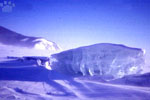
Ice, Lake Baikal. |
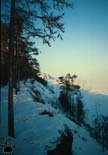
Northwestern coast of
Lake Baikal. |
The lake is of special interest to meteorologists and
zoologists because of its unique weather patterns, such as sarma,
and more than 200 species of endemic creatures in the lake itself. Only two other
lakes in the world have similar levels of biodiversity: Tanganyika in Africa,
and, to much lesser extent, Ohrid in the Balkans. You can dive in most parts of
Baikal, but the water temperature is above 12 C (54F) only in some parts of Chvyrkui
Bay on the eastern side, and only in July and early August. The famous nerpa
(Phoca sibirica), the World's smallest seal, is difficult to see. It spends
most of winter in caves between ice and snow, but can be seen in spring on melting
ice fields, or in summer on small remote islands. |
| Most tourists cross Siberia along the well-known Transsiberian
Railroad. I find this route dull and way too long. The surrounding areas were
all colonized by Russians many decades ago, so you see identical villages, towns
and secondary forests almost everywhere. The new Baikal-Amur railroad (BAM)
to the north of the Transsiberian passes through more diverse and spectacular
lands, high mountains and deep rift valleys. The surrounding forests have also
suffered serious damage from logging and fires, but now, as the railroad is almost
non-operational in some parts, they slowly recover. The older Western BAM is now
surrounded with dense taiga, mostly spruce and pine. |
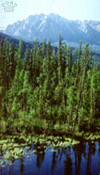
Western BAM area. |
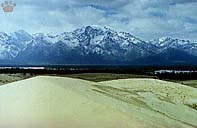
Chara Sands and Kodar Range, Russia. |
One of the most beautiful places along BAM is Chara Valley
south from Kodar Range, famous for its rock climbing sites. From Chara eastward,
almost all forests are larch, and many areas look like tundra woodlands. Eastern
BAM is less populated, and passenger trains only pass there once or twice a day
in each direction. Small stations are good starting points for exploring surrounding
mountains and valleys. |
| There is only one species of chipmunk in Siberia (Tamias sibiricus),
but you see it everywhere, and in taiga forests with "cedar" (pines
Pinus sibiricus and P. koraensis) it is the most common mammal.
Local tribes use its caches of pine nuts in winter, and bears do so in autumn.
European squirrel (Sciurus vulgaris) is also widespread, and some local
races are very beautiful in winter. Flying squirrel (Pteromys volans) is
common, but difficult to see. |

Chipmunk, Oo, Buryatia. |

Solar eclipse,
Tynda vicinity, Russia. |
In March 1997, I organized a trip to the eastern part
of BAM to watch the total solar eclipse. I did some advertising via Internet,
but most people did not dare go to a place so cold. Only 4 tourists from Canada
and Hong Kong joined me. We enjoyed the longest totality time, excellent weather,
and beautiful setting. A wolf pack saluted the event from a neighboring valley.
We also saw Comet Hale-Bopp during the totality, and I sent a
report to one of comet-watching sites. Meanwhile, thousands of people tried
to watch the eclipse from Mongolia and China, but saw almost nothing because of
bad weather. |
| The territory north from Kolyma Highway is mostly mountains.
Only the large area adjacent to the East Siberian Sea is absolutely flat. This
lake-dotted country between Indigirka and Kolyma deltas is almost uninhabited.
Native Yukagir people have mostly died out when herds of wild reindeer disappeared
because of hunting on wintering grounds and competition from domestic reindeer
of neighboring tribes. Their fate was shared by Inland Eskimos of Canada and other
tundra hunters who didn't have domestic reindeer. |
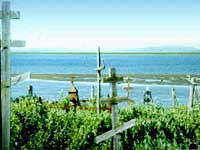
Old cemetery, Pohodsk, Yakutia. Graves
of Yukagirs are decorated with wooden geese. |
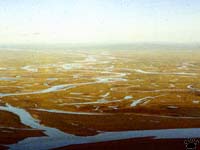
Lake tundra, Pohodsk, Yakutia. |
In the old village of Pohodsk on Kolyma river, there
are still some Yukagirs, but most people are descendants of Russian Cossacks.
They settled here after "seeing a rainbow of unearthly beauty" in the
late 16th century. The village was later decimated by smallpox epidemic, and now
there are only a few dozen people here. The village cemetery has received some
recent attention as a potential source of smallpox virus. It has been almost washed
away by Kolyma, but some coffins are still visible in the permafrost. |
| The maze of small lakes and willow-covered
lowland tundra west of Kolyma is known as the main breeding area of Siberian crane
(Grus leucogeranus) and Ross' gull (Larus roseus). In winter, it
is the most desolate of all Eurasian tundras. Mountain tundras east from Kolyma
have more diverse flora and fauna, with some American species. The diversity increases
as you move east, into Chukotka. Cliffs on this picture,
a famous nesting site of white gyrfalcons (Falco rusticolus), are, in fact,
a more important biogeographical border than the Bering Strait. |
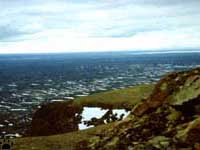
Edge of mountain tundra, Cherskii, Yakutia. |
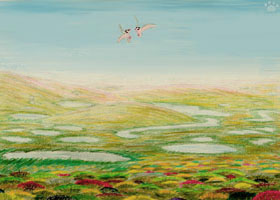
Ross' gulls, Chokurdah, Yakutia.
Home
|

